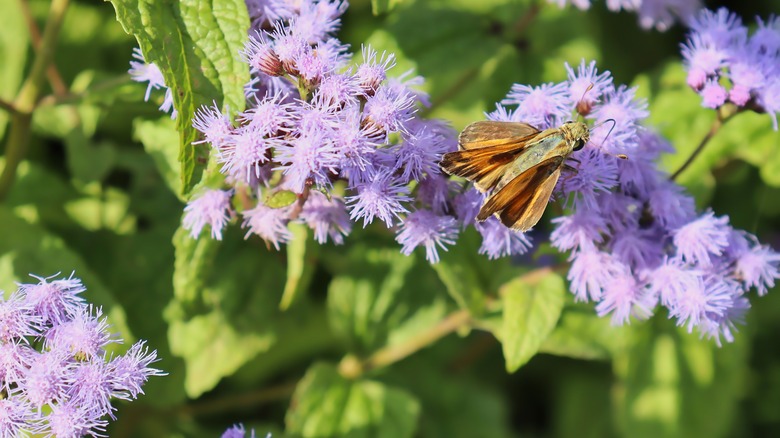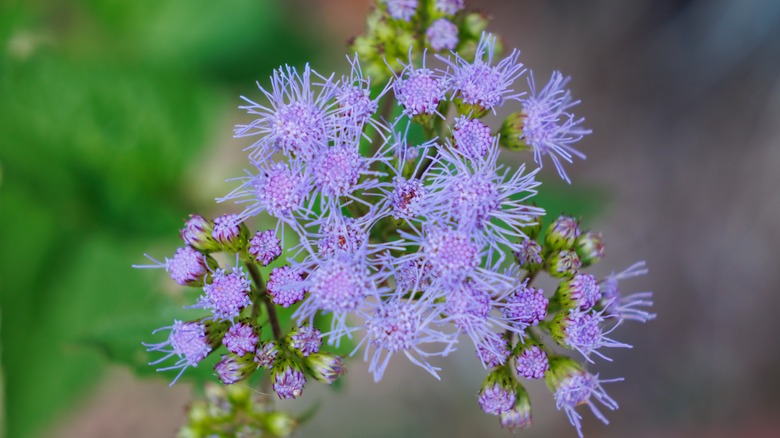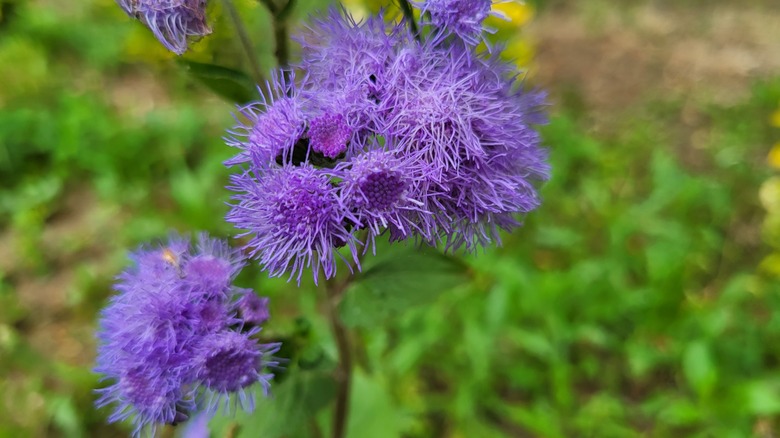Pollinators Love Blue Mistflower, But Is It A Friendly Plant Or A Garden Foe?
The blue mistflower is a lovely late-season perennial that bears fuzzy periwinkle blue flowers (some varieties come in shades of white and reddish violet). The plant is also known as perennial ageratum and blue boneset, and has the botanical name Conoclinium coelestinum. This stunning blue flower brings color to the late-summer garden. In sunny conditions, blue mistflower tends to spread a bit, causing some gardeners to find it invasive. Thankfully, with the right strategy, this pollinator-friendly plant is fairly easy to control: a friend, not a foe.
Not to be confused with annual ageratum, perennial ageratum is much taller and has larger leaves. It makes a good perennial for the flower bed (where most other perennials bloom in early to mid-summer) because its flowers don't appear until August. Plus, they last several weeks, perking up the late-summer flower bed with delicate texture and much-needed color. Each blossom is full of nectar, too and is especially attractive to skippers, bees, and butterflies.
Blue mistflower wakes up rather late in spring, and its textured leaves are fairly easy to recognize. The root systems are shallow and not terribly substantial, so they can easily be dug up or even pulled from the ground if the clumps start to spread too far. There are other ways to help keep this eager (but manageable) perennial from spreading too much in the garden. For some gardeners, the burst of late-summer color is worth a bit of effort.
Blue mistflower growth factors
The mistflower is a cold-hardy perennial and blooms very reliably in partial shade to full sun. Planting it in full sun will generally cause more prolific growth, therefore encouraging the flower to spread in your garden. If you want to keep the mistflower's range to a minimum, planting it in partial shade seems to keep it from spreading too quickly. But if you're okay with some occasional digging or pulling to keep it in check, full sun is also suitable.
Two other factors affecting this plant's growth are soil and moisture. The mistflower grows in many types of soil, including clay; however, planting mistflower in a loose, well-drained soil that is rich with organic matter and compost will make it easier to pull up by the shallow roots after a rainfall when the ground is damp. Add organic matter to your heavy clay soil to improve texture and drainage before planting.
Mistflower also prefers a damp soil and even grows well in swampy or boggy meadows or creekside and pondside areas. But again, a well-drained soil is best for keeping this plant's spreading tendencies under control. In dry spells during the summer, be sure to water it as needed to allow buds to form fully and produce abundant late-season flowers for birds and bees. Placing a light layer of natural mulch will also help preserve moisture around your mistflower plantings.
How to keep mistflower from spreading
Although anecdotally, some gardeners may find mistflower to be invasive, it is not officially listed this way by most gardening associations or horticultural sources. However, this plant is definitely an assertive, if not aggressive grower. In addition to making sure the soil, moisture, and sun exposure conditions are suitable for this perennial, there are other tips for keeping it from spreading invasively in the garden.
One trick to be aware of when planting different perennials together is to know their growth habits. This means not only knowing the timing of their flowering and how tall they get, but the kinds of root systems they have and how those roots spread in the garden. Some plants have shallow, spreading roots, while others have deep tap roots. Since mistflower has a shallow, spreading type of root, it's best not to locate them next to other plants with similar roots, such as yarrow, threadleaf coreopsis, or garden phlox.
Another good tip for helping keep this spreading perennial in check is by dividing in the fall (or pull up some of the plants by the roots). When the new shoots appear in late spring, you can either keep them as is, or lightly pull out a few more from the clump as desired. This colorful flower does take a small amount of effort to keep it from spreading, but for experienced gardeners, it's a well-loved addition beloved by pollinators.


